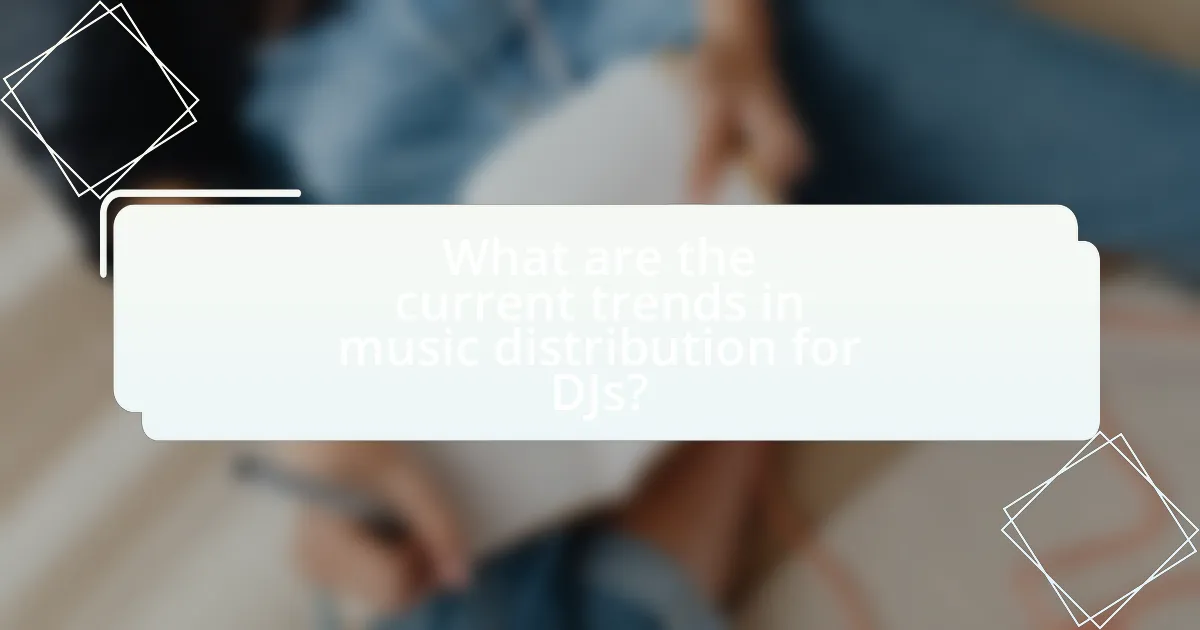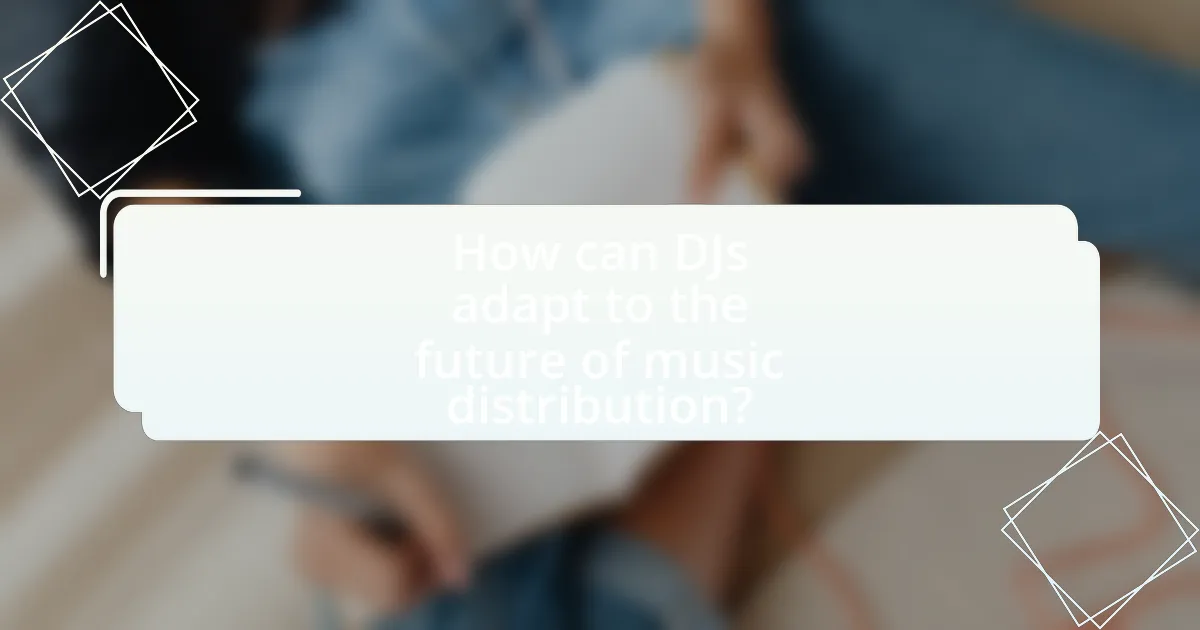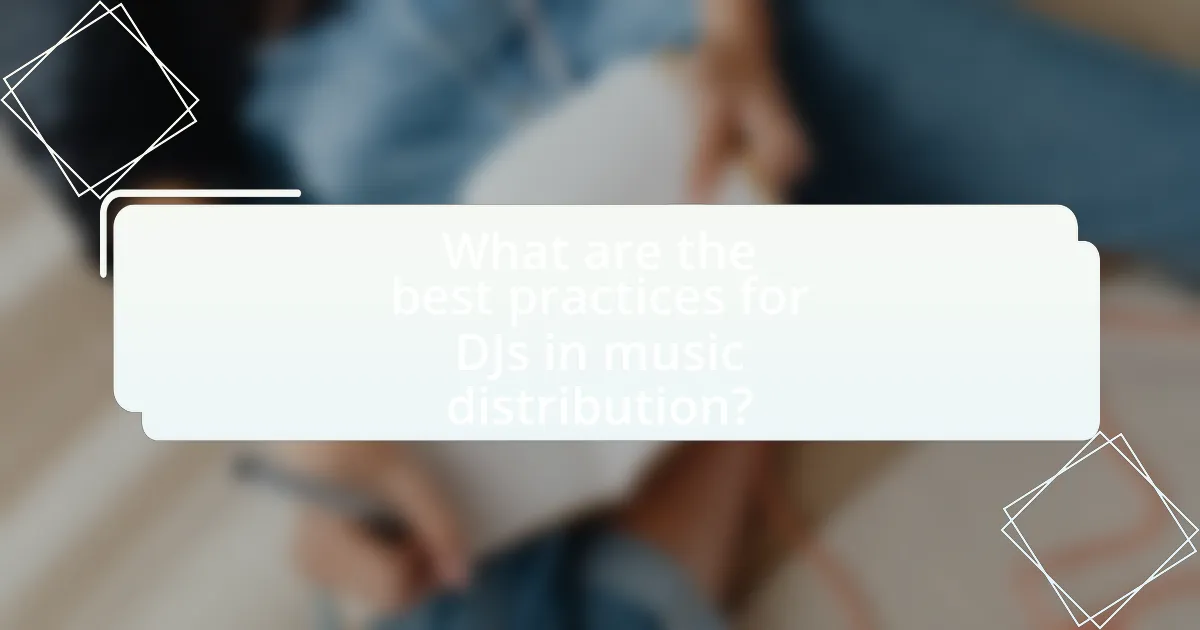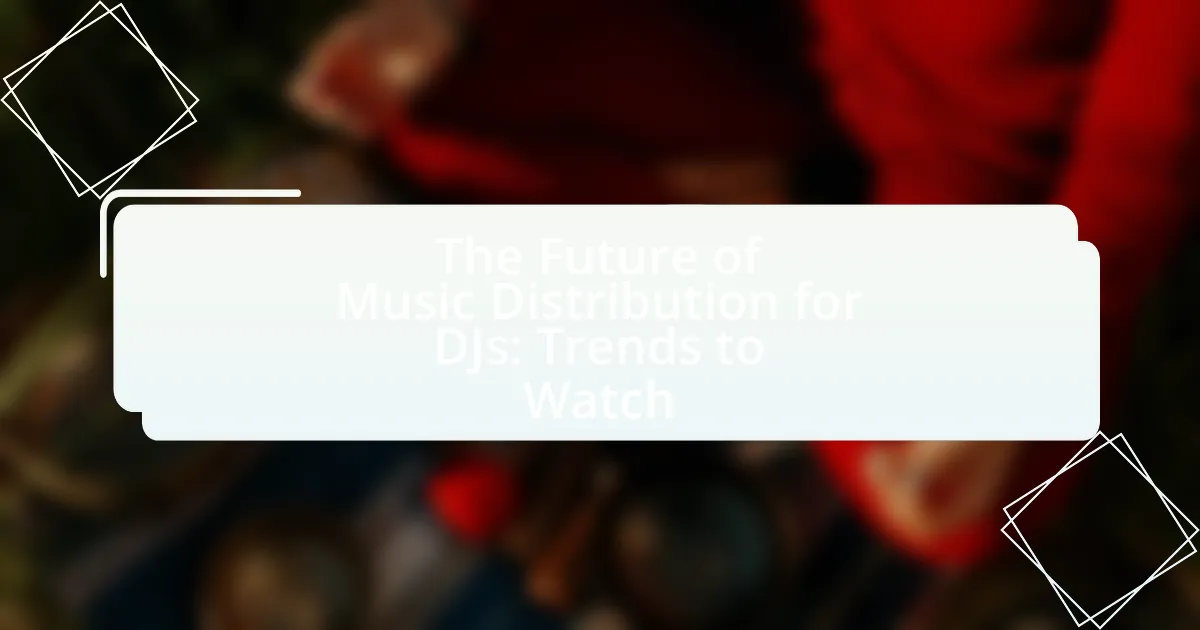The article focuses on the evolving landscape of music distribution for DJs, highlighting current trends such as the rise of digital platforms, direct-to-fan sales, and the increasing role of social media in promotion. It examines how technology influences distribution, the significance of streaming platforms, and the emergence of new platforms like Twitch and Mixcloud. Additionally, the article addresses challenges DJs face, including copyright issues and financial implications of new distribution models, while providing strategies for adapting to future trends and leveraging analytics for improved engagement. Best practices for successful distribution and common pitfalls to avoid are also discussed, emphasizing the importance of compliance with copyright laws and effective marketing techniques.

What are the current trends in music distribution for DJs?
Current trends in music distribution for DJs include the rise of digital platforms, direct-to-fan sales, and the use of social media for promotion. Digital platforms like Spotify, SoundCloud, and Beatport have become essential for DJs to distribute their music widely and reach global audiences. Direct-to-fan sales through platforms such as Bandcamp allow DJs to retain a larger share of revenue while building a direct relationship with their listeners. Additionally, social media channels like Instagram and TikTok are increasingly utilized for marketing and promoting new releases, enabling DJs to engage with fans and create viral content that drives music discovery. These trends reflect the evolving landscape of music distribution, emphasizing accessibility and direct engagement with audiences.
How is technology influencing music distribution for DJs?
Technology is significantly influencing music distribution for DJs by enabling instant access to vast libraries of music through digital platforms. This shift from physical formats to streaming services allows DJs to discover, purchase, and share tracks more efficiently, enhancing their ability to curate sets tailored to specific audiences. For instance, platforms like Beatport and SoundCloud provide DJs with access to new releases and underground tracks, facilitating a more dynamic music selection process. Additionally, advancements in cloud storage and file-sharing technologies enable DJs to collaborate remotely and share their playlists seamlessly, further streamlining the distribution process.
What role do streaming platforms play in DJ music distribution?
Streaming platforms serve as crucial channels for DJ music distribution by providing artists with a global audience and facilitating easy access to their tracks. These platforms, such as Spotify, Apple Music, and SoundCloud, enable DJs to upload their mixes and original productions, reaching millions of listeners without the need for traditional record labels. According to a report by the International Federation of the Phonographic Industry (IFPI), streaming accounted for 62.1% of global recorded music revenues in 2020, highlighting its significance in the music industry. Additionally, streaming platforms often include features that allow DJs to promote their work through playlists and collaborations, further enhancing their visibility and engagement with fans.
How are social media and digital marketing changing the landscape for DJs?
Social media and digital marketing are transforming the landscape for DJs by enabling direct engagement with audiences and facilitating music distribution. DJs can now leverage platforms like Instagram, TikTok, and Facebook to showcase their work, build a personal brand, and connect with fans in real-time, which enhances their visibility and reach. According to a 2021 report by Statista, 54% of social media users utilize these platforms to discover new music, indicating that social media is a critical tool for DJs to promote their tracks and events. Furthermore, digital marketing strategies, such as targeted advertising and influencer partnerships, allow DJs to effectively reach specific demographics, optimizing their promotional efforts and increasing their chances of success in a competitive industry.
What are the emerging platforms for DJ music distribution?
Emerging platforms for DJ music distribution include SoundCloud, Bandcamp, and DistroKid. SoundCloud allows DJs to upload and share their mixes, gaining exposure through its community-driven model. Bandcamp offers a direct-to-fan sales approach, enabling DJs to sell their music while retaining a larger share of revenue. DistroKid simplifies the distribution process by allowing DJs to release their music across multiple streaming services quickly. These platforms are gaining traction due to their user-friendly interfaces and the ability to reach wider audiences, reflecting the evolving landscape of music distribution for DJs.
Which new platforms are gaining popularity among DJs?
New platforms gaining popularity among DJs include Twitch, Mixcloud, and Beatport LINK. Twitch has emerged as a significant platform for live streaming DJ sets, allowing DJs to engage with audiences in real-time. Mixcloud offers a unique service for DJs to upload and share mixes while ensuring copyright compliance, which is increasingly important in the digital landscape. Beatport LINK provides DJs with access to a vast library of tracks for live performances, integrating seamlessly with DJ software. These platforms reflect the evolving landscape of music distribution and engagement for DJs.
How do these platforms differ from traditional distribution methods?
These platforms differ from traditional distribution methods by offering direct access to audiences and real-time analytics. Unlike traditional methods, which often involve intermediaries like record labels and distributors, these platforms enable DJs to distribute their music directly to listeners, reducing costs and increasing profit margins. Additionally, they provide data on listener engagement and preferences, allowing DJs to tailor their marketing strategies effectively. This shift reflects a broader trend towards democratization in music distribution, where artists retain more control over their work and revenue streams.
What challenges do DJs face in the evolving distribution landscape?
DJs face significant challenges in the evolving distribution landscape, primarily due to the rapid shift towards digital platforms and the saturation of the market. The transition from physical to digital distribution has led to increased competition, making it difficult for individual DJs to stand out. Additionally, the prevalence of streaming services has altered revenue models, often resulting in lower payouts for artists compared to traditional sales. According to a 2021 report by the International Federation of the Phonographic Industry, streaming accounted for 62% of global recorded music revenue, highlighting the dominance of this model and the financial pressures it places on DJs. Furthermore, the need for constant content creation and engagement on social media platforms adds to the workload, complicating their ability to focus on music production and performance.
How do copyright issues affect DJs in music distribution?
Copyright issues significantly impact DJs in music distribution by limiting their ability to legally use and distribute copyrighted music without obtaining proper licenses. DJs often face legal repercussions, including fines and lawsuits, if they play or distribute tracks without permission from copyright holders. For instance, the U.S. Copyright Act mandates that DJs must secure licenses from performing rights organizations like ASCAP or BMI to play copyrighted music in public venues. Failure to comply can result in penalties, which can deter DJs from exploring diverse music selections and hinder their promotional efforts.
What are the financial implications of new distribution models for DJs?
New distribution models for DJs significantly impact their financial landscape by altering revenue streams and reducing costs. These models, such as digital streaming platforms and direct-to-fan sales, enable DJs to reach wider audiences without traditional intermediaries, thus increasing potential earnings. For instance, the rise of platforms like Bandcamp allows DJs to sell music directly to fans, retaining a larger percentage of sales compared to traditional record labels, which typically take a substantial cut. Additionally, the shift towards streaming services has led to a decrease in physical distribution costs, allowing DJs to allocate resources more efficiently. According to a report by the International Federation of the Phonographic Industry (IFPI), global recorded music revenues grew by 7.4% in 2020, largely driven by streaming, indicating a shift in how DJs can monetize their work.

How can DJs adapt to the future of music distribution?
DJs can adapt to the future of music distribution by embracing digital platforms and utilizing data analytics to understand audience preferences. As streaming services continue to dominate music consumption, DJs should leverage platforms like Spotify, SoundCloud, and Bandcamp to distribute their mixes and original tracks, reaching wider audiences. Additionally, incorporating data analytics tools can help DJs tailor their sets based on listener trends, enhancing engagement and satisfaction. According to a report by the International Federation of the Phonographic Industry (IFPI), streaming accounted for 62.1% of global recorded music revenue in 2020, highlighting the importance of digital adaptation for DJs.
What strategies can DJs employ to stay relevant in music distribution?
DJs can stay relevant in music distribution by leveraging digital platforms, engaging with audiences through social media, and collaborating with emerging artists. Utilizing platforms like Spotify, SoundCloud, and Bandcamp allows DJs to distribute their mixes and original tracks widely, reaching global audiences. Engaging with fans on social media platforms such as Instagram and TikTok fosters community and promotes new releases, as these platforms are increasingly influential in music discovery. Collaborating with emerging artists not only diversifies a DJ’s sound but also taps into the fan bases of those artists, enhancing visibility. According to a 2021 report by the International Federation of the Phonographic Industry, digital music revenues accounted for 62% of the global recorded music market, highlighting the importance of digital distribution strategies for relevance in the industry.
How can DJs leverage analytics to improve their distribution strategies?
DJs can leverage analytics to improve their distribution strategies by analyzing listener data to identify trends and preferences. By utilizing platforms that provide insights into streaming statistics, demographic information, and engagement metrics, DJs can tailor their music releases and marketing efforts to better align with their audience’s tastes. For instance, data from services like Spotify and SoundCloud can reveal which tracks are most popular among specific demographics, allowing DJs to focus their distribution on platforms that yield the highest engagement. Additionally, tracking social media interactions can help DJs understand which promotional strategies resonate most with their fans, leading to more effective distribution campaigns.
What role does networking play in a DJ’s distribution success?
Networking is crucial for a DJ’s distribution success as it facilitates connections with industry professionals, promoters, and other artists, enhancing visibility and opportunities for collaboration. By building relationships within the music community, DJs can gain access to distribution channels, receive support for their releases, and increase their chances of being featured in playlists or events. For instance, a study by the International Music Summit in 2021 highlighted that 70% of successful DJs attribute their career advancements to networking, demonstrating its significant impact on distribution outcomes.
How can DJs utilize technology to enhance their distribution efforts?
DJs can utilize technology to enhance their distribution efforts by leveraging digital platforms and social media for wider reach and engagement. Digital distribution services like DistroKid and TuneCore allow DJs to upload their music to multiple streaming platforms simultaneously, increasing visibility. Additionally, social media platforms such as Instagram and TikTok enable DJs to promote their tracks and connect with audiences directly, fostering a community around their music. According to a 2021 report by the International Federation of the Phonographic Industry, digital music revenues accounted for 62% of the global music market, highlighting the importance of technology in music distribution.
What tools are available for DJs to streamline their distribution process?
DJs can streamline their distribution process using tools such as digital distribution platforms, social media management software, and music promotion services. Digital distribution platforms like DistroKid and TuneCore allow DJs to upload their music to multiple streaming services efficiently, ensuring wider reach and faster availability. Social media management tools, such as Hootsuite or Buffer, help DJs schedule and manage promotional content across various platforms, enhancing audience engagement. Additionally, music promotion services like SubmitHub enable DJs to connect with bloggers and playlist curators, facilitating targeted outreach and increasing the chances of their music being featured. These tools collectively enhance the efficiency and effectiveness of the distribution process for DJs.
How can DJs use automation in their music distribution workflows?
DJs can use automation in their music distribution workflows by implementing software tools that streamline the process of uploading, scheduling, and promoting their tracks across multiple platforms. Automation tools like DistroKid or TuneCore allow DJs to distribute their music to various streaming services simultaneously, reducing the time and effort required for manual uploads. Additionally, automated social media posting tools can help DJs promote their releases effectively, ensuring consistent engagement with their audience. According to a 2021 report by the International Federation of the Phonographic Industry, digital music distribution has increased by 19.9%, highlighting the importance of efficient workflows in a competitive market.

What are the best practices for DJs in music distribution?
The best practices for DJs in music distribution include utilizing digital platforms, engaging with audiences on social media, and ensuring proper licensing of tracks. Digital platforms like Spotify, Apple Music, and SoundCloud provide DJs with extensive reach and accessibility to listeners. Engaging with audiences through social media channels helps build a loyal fan base and promotes new releases effectively. Additionally, proper licensing is crucial to avoid legal issues and ensure that artists receive fair compensation for their work, as highlighted by the Music Modernization Act of 2018, which emphasizes the importance of copyright compliance in music distribution.
How can DJs effectively promote their music through distribution channels?
DJs can effectively promote their music through distribution channels by leveraging digital platforms and social media to reach wider audiences. Utilizing services like Spotify, Apple Music, and SoundCloud allows DJs to distribute their tracks globally, while social media platforms such as Instagram and TikTok enable them to engage with fans and create viral content. According to a 2021 report by the International Federation of the Phonographic Industry, digital music revenues accounted for 62% of the global recorded music market, highlighting the importance of online distribution. Additionally, collaborating with influencers and other artists can amplify their reach, as partnerships often lead to cross-promotion and increased visibility.
What marketing techniques are most effective for DJs today?
Social media marketing, particularly through platforms like Instagram, TikTok, and Facebook, is the most effective technique for DJs today. These platforms allow DJs to showcase their music, engage with fans, and promote events in real-time. For instance, TikTok has become a powerful tool for music discovery, with tracks going viral and leading to increased streaming and event attendance. According to a 2022 report by the International Music Summit, 70% of DJs reported that social media significantly boosted their visibility and fan engagement. Additionally, email marketing remains crucial, as it enables DJs to directly communicate with their audience about upcoming shows and releases, fostering a loyal fanbase.
How can DJs build a loyal fanbase through their distribution efforts?
DJs can build a loyal fanbase through their distribution efforts by consistently releasing high-quality music on multiple platforms and engaging with their audience. By utilizing platforms like Spotify, SoundCloud, and Bandcamp, DJs can reach a wider audience and keep fans updated with new releases. Engaging with fans through social media and email newsletters fosters a sense of community and loyalty. According to a 2021 report by the International Federation of the Phonographic Industry, artists who actively engage with their audience on social media see a 30% increase in fan retention. This combination of quality content and direct engagement solidifies a DJ’s presence in the music scene, leading to a dedicated fanbase.
What common mistakes should DJs avoid in music distribution?
DJs should avoid several common mistakes in music distribution, including neglecting proper metadata, failing to understand licensing requirements, and not utilizing multiple distribution platforms. Proper metadata is crucial as it ensures that tracks are correctly attributed and searchable, which can significantly impact visibility and sales. Understanding licensing is essential to avoid legal issues, as unauthorized use of samples or tracks can lead to copyright infringement. Additionally, relying solely on one distribution platform limits reach; utilizing multiple platforms can enhance exposure and revenue opportunities.
How can DJs ensure compliance with copyright laws during distribution?
DJs can ensure compliance with copyright laws during distribution by obtaining the necessary licenses for the music they use. This involves securing permissions from copyright holders or using licensed platforms that provide access to music for public performance and distribution. For instance, organizations like ASCAP, BMI, and SESAC offer licensing options that cover various uses of music, ensuring that DJs can legally distribute their mixes. Additionally, utilizing royalty-free music or tracks from Creative Commons can further help DJs avoid copyright infringement while distributing their work.
What pitfalls should DJs watch out for when choosing distribution platforms?
DJs should watch out for several pitfalls when choosing distribution platforms, including hidden fees, lack of transparency, and limited reach. Hidden fees can significantly reduce earnings, as some platforms charge for services that are not clearly outlined upfront. Lack of transparency in terms of royalties and payment schedules can lead to confusion and mistrust. Additionally, limited reach may hinder a DJ’s ability to connect with a broader audience, as some platforms may not distribute music to all major streaming services. According to a 2022 survey by the International Music Summit, 45% of DJs reported dissatisfaction with their distribution platform due to these issues, highlighting the importance of thorough research before making a choice.
What practical tips can DJs implement for successful music distribution?
DJs can implement several practical tips for successful music distribution, including leveraging digital platforms, building a strong online presence, and engaging with their audience. Utilizing platforms like Spotify, SoundCloud, and Bandcamp allows DJs to reach a wider audience and distribute their music efficiently. A strong online presence, through social media and a professional website, enhances visibility and connects DJs with fans and industry professionals. Engaging with the audience through live streams, Q&A sessions, and interactive content fosters loyalty and encourages sharing, which can amplify distribution efforts. According to a 2021 report by the International Federation of the Phonographic Industry, digital music revenues accounted for 62% of the global music market, highlighting the importance of effective digital distribution strategies for DJs.

Leave a Reply